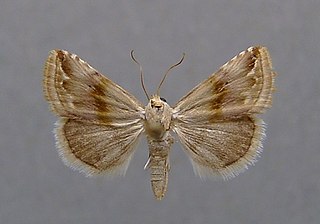
The small angle shades is a moth of the family Noctuidae. It is distributed throughout the Palearctic. The species was first described by Carl Linnaeus in his 1758 10th edition of Systema Naturae.

Acrapex brunnea is a species of moth of the family Noctuidae first described by George Hampson in 1910. It is found in Africa, including Angola, Kenya and South Africa.

Acrapex carnea is a species of moth of the family Noctuidae first described by George Hampson in 1905. It is found in Africa, including South Africa.

Acrapex leucophlebia is a species of moth of the family Noctuidae first described by George Hampson in 1894. It is found in the Nilgiri Mountains of India.

Acrapex metaphaea is a species of moth of the family Noctuidae first described by George Hampson in 1910. It is found in Africa, including Zimbabwe and South Africa.

Acrapex rhabdoneura is a species of moth of the family Noctuidae first described by George Hampson in 1910. It is found in Africa, including Kenya.

Acrapex spoliata is a species of moth of the family Noctuidae first described by Francis Walker in 1863. It is found in Africa, including Sierra Leone and South Africa.

Amolita perstriata is a species of moth in the family Erebidae first described by George Hampson in 1910. The species is found on the Bahamas. Its wingspan is about 22 mm.

Acylita elongata is a species of moth of the family Noctuidae first described by William Schaus in 1906. It is found in Brazil. Its wingspan is about 34 mm.

Actinotia polyodon, the purple cloud, is a moth of the family Noctuidae. It is found in much of the Palearctic realm, from Europe to Russia and Japan.

Eublemma ostrina, the purple marbled, is a moth of the family Erebidae. The species was first described by Jacob Hübner in 1808. It is mainly found in central and southern Europe, and further east, but is also a scarce migrant in the United Kingdom, where it is mainly found along the south coast.

Ichneutica oliveri is a moth of the family Noctuidae. It is endemic to New Zealand, found only in the South Island. However it has not been observed on the eastern side of that island from mid-Canterbury southwards to Southland. This species is distinctive and is unlikely to be confused with other closely related species. It inhabits tussock grasslands, shrubland as well as granite sand plains, all in the alpine zone. Adults are on the wing from December to March and are attracted to light. They have been observed feeding on the flowers of Hebe species. The life history of this species is unknown as are the larval hosts.
Trichromia phaeocrota is a moth in the family Erebidae. It is found in French Guiana and Venezuela.
Dichogama diffusalis is a moth in the family Crambidae. It was described by George Hampson in 1918. It is found in Venezuela and Costa Rica.
Clupeosoma atristriata is a moth in the family Crambidae. It was described by George Hampson in 1917. It is found in Papua New Guinea, including the Bismarck Archipelago and Indonesia, where it has been recorded from Timur.
Clupeosoma rufistriata is a moth in the family Crambidae. It was described by George Hampson in 1917. It is found in New Guinea.
Phostria chrysomera is a species of moth in the family Crambidae. It was described by George Hampson in 1918. It is found in Peru.
Ambia melanistis is a moth in the family Crambidae. It was described by George Hampson in 1917 and it is found in Taiwan.
Antaeotricha oxycentra is a moth of the family Depressariidae. It is found in the Guianas and Brazil.

Ichneutica chlorodonta, also known as the Green-toothed Owlet, is a moth of the family Noctuidae. This species is endemic to New Zealand. It is found throughout the North, South and Stewart Islands and is associated with native forest and shrubland. It can be confused with similar looking species such as I. subcyprea however I. chlorodonta can be distinguished through differences in colouration of its fore and hind wings as well as the length of the male pectinations. The life history of this species is unknown as are the host species of its larvae but adults of I. chlorodonta are on the wing from September to April.




